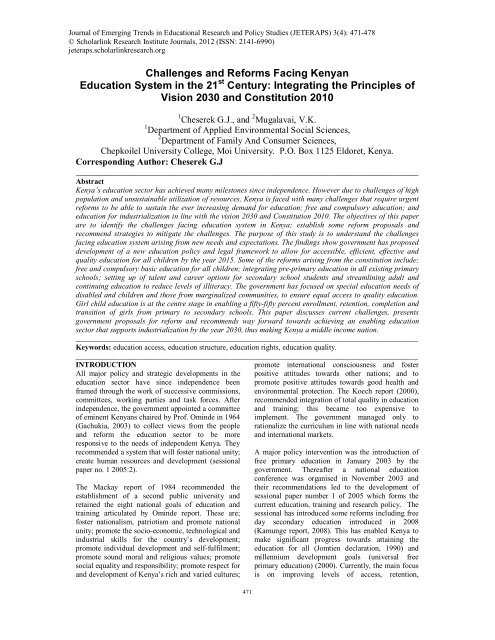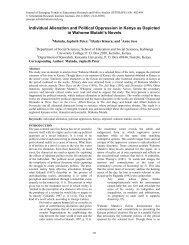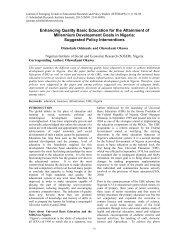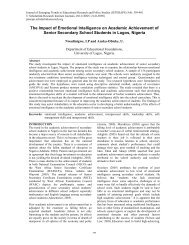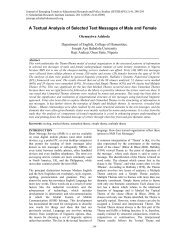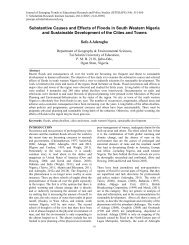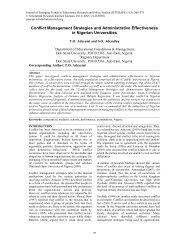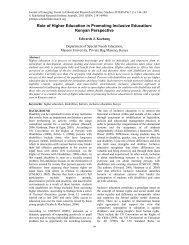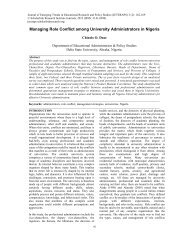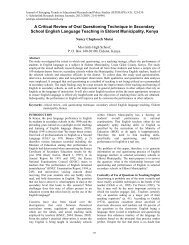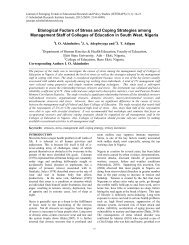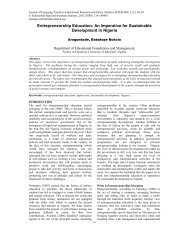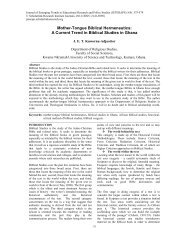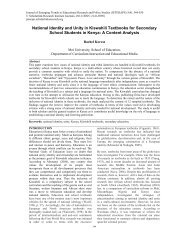Challenges and Reforms Facing Kenyan Education System in the ...
Challenges and Reforms Facing Kenyan Education System in the ...
Challenges and Reforms Facing Kenyan Education System in the ...
You also want an ePaper? Increase the reach of your titles
YUMPU automatically turns print PDFs into web optimized ePapers that Google loves.
Journal of Emerg<strong>in</strong>g Trends <strong>in</strong> <strong>Education</strong>al Research <strong>and</strong> Policy Studies (JETERAPS) 3(4): 471-478<br />
Journal © Scholarl<strong>in</strong>k of Emerg<strong>in</strong>g Research Trends Institute <strong>in</strong> <strong>Education</strong>al Journals, 2012 Research (ISSN: <strong>and</strong> 2141-6990) Policy Studies (JETERAPS) 3(4):471-478 (ISSN:2141-6990)<br />
jeteraps.scholarl<strong>in</strong>kresearch.org<br />
<strong>Challenges</strong> <strong>and</strong> <strong>Reforms</strong> <strong>Fac<strong>in</strong>g</strong> <strong>Kenyan</strong><br />
<strong>Education</strong> <strong>System</strong> <strong>in</strong> <strong>the</strong> 21 st Century: Integrat<strong>in</strong>g <strong>the</strong> Pr<strong>in</strong>ciples of<br />
Vision 2030 <strong>and</strong> Constitution 2010<br />
1 Cheserek G.J., <strong>and</strong> 2 Mugalavai, V.K.<br />
1 Department of Applied Environmental Social Sciences,<br />
2 Department of Family And Consumer Sciences,<br />
Chepkoilel University College, Moi University. P.O. Box 1125 Eldoret, Kenya.<br />
Correspond<strong>in</strong>g Author: Cheserek G.J<br />
___________________________________________________________________________<br />
Abstract<br />
Kenya’s education sector has achieved many milestones s<strong>in</strong>ce <strong>in</strong>dependence. However due to challenges of high<br />
population <strong>and</strong> unsusta<strong>in</strong>able utilization of resources, Kenya is faced with many challenges that require urgent<br />
reforms to be able to susta<strong>in</strong> <strong>the</strong> ever <strong>in</strong>creas<strong>in</strong>g dem<strong>and</strong> for education; free <strong>and</strong> compulsory education; <strong>and</strong><br />
education for <strong>in</strong>dustrialization <strong>in</strong> l<strong>in</strong>e with <strong>the</strong> vision 2030 <strong>and</strong> Constitution 2010. The objectives of this paper<br />
are to identify <strong>the</strong> challenges fac<strong>in</strong>g education system <strong>in</strong> Kenya; establish some reform proposals <strong>and</strong><br />
recommend strategies to mitigate <strong>the</strong> challenges. The purpose of this study is to underst<strong>and</strong> <strong>the</strong> challenges<br />
fac<strong>in</strong>g education system aris<strong>in</strong>g from new needs <strong>and</strong> expectations. The f<strong>in</strong>d<strong>in</strong>gs show government has proposed<br />
development of a new education policy <strong>and</strong> legal framework to allow for accessible, efficient, effective <strong>and</strong><br />
quality education for all children by <strong>the</strong> year 2015. Some of <strong>the</strong> reforms aris<strong>in</strong>g from <strong>the</strong> constitution <strong>in</strong>clude;<br />
free <strong>and</strong> compulsory basic education for all children; <strong>in</strong>tegrat<strong>in</strong>g pre-primary education <strong>in</strong> all exist<strong>in</strong>g primary<br />
schools; sett<strong>in</strong>g up of talent <strong>and</strong> career options for secondary school students <strong>and</strong> streaml<strong>in</strong><strong>in</strong>g adult <strong>and</strong><br />
cont<strong>in</strong>u<strong>in</strong>g education to reduce levels of illiteracy. The government has focused on special education needs of<br />
disabled <strong>and</strong> children <strong>and</strong> those from marg<strong>in</strong>alized communities, to ensure equal access to quality education.<br />
Girl child education is at <strong>the</strong> centre stage <strong>in</strong> enabl<strong>in</strong>g a fifty-fifty percent enrollment, retention, completion <strong>and</strong><br />
transition of girls from primary to secondary schools. This paper discusses current challenges, presents<br />
government proposals for reform <strong>and</strong> recommends way forward towards achiev<strong>in</strong>g an enabl<strong>in</strong>g education<br />
sector that supports <strong>in</strong>dustrialization by <strong>the</strong> year 2030, thus mak<strong>in</strong>g Kenya a middle <strong>in</strong>come nation.<br />
__________________________________________________________________________________________<br />
Keywords: education access, education structure, education rights, education quality.<br />
__________________________________________________________________________________________<br />
INTRODUCTION<br />
All major policy <strong>and</strong> strategic developments <strong>in</strong> <strong>the</strong><br />
education sector have s<strong>in</strong>ce <strong>in</strong>dependence been<br />
framed through <strong>the</strong> work of successive commissions,<br />
committees, work<strong>in</strong>g parties <strong>and</strong> task forces. After<br />
<strong>in</strong>dependence, <strong>the</strong> government appo<strong>in</strong>ted a committee<br />
of em<strong>in</strong>ent <strong>Kenyan</strong>s chaired by Prof. Om<strong>in</strong>de <strong>in</strong> 1964<br />
(Gachukia, 2003) to collect views from <strong>the</strong> people<br />
<strong>and</strong> reform <strong>the</strong> education sector to be more<br />
responsive to <strong>the</strong> needs of <strong>in</strong>dependent Kenya. They<br />
recommended a system that will foster national unity;<br />
create human resources <strong>and</strong> development (sessional<br />
paper no. 1 2005:2).<br />
The Mackay report of 1984 recommended <strong>the</strong><br />
establishment of a second public university <strong>and</strong><br />
reta<strong>in</strong>ed <strong>the</strong> eight national goals of education <strong>and</strong><br />
tra<strong>in</strong><strong>in</strong>g articulated by Om<strong>in</strong>de report. These are;<br />
foster nationalism, patriotism <strong>and</strong> promote national<br />
unity; promote <strong>the</strong> socio-economic, technological <strong>and</strong><br />
<strong>in</strong>dustrial skills for <strong>the</strong> country’s development;<br />
promote <strong>in</strong>dividual development <strong>and</strong> self-fulfilment;<br />
promote sound moral <strong>and</strong> religious values; promote<br />
social equality <strong>and</strong> responsibility; promote respect for<br />
<strong>and</strong> development of Kenya’s rich <strong>and</strong> varied cultures;<br />
471<br />
promote <strong>in</strong>ternational consciousness <strong>and</strong> foster<br />
positive attitudes towards o<strong>the</strong>r nations; <strong>and</strong> to<br />
promote positive attitudes towards good health <strong>and</strong><br />
environmental protection. The Koech report (2000),<br />
recommended <strong>in</strong>tegration of total quality <strong>in</strong> education<br />
<strong>and</strong> tra<strong>in</strong><strong>in</strong>g; this became too expensive to<br />
implement. The government managed only to<br />
rationalize <strong>the</strong> curriculum <strong>in</strong> l<strong>in</strong>e with national needs<br />
<strong>and</strong> <strong>in</strong>ternational markets.<br />
A major policy <strong>in</strong>tervention was <strong>the</strong> <strong>in</strong>troduction of<br />
free primary education <strong>in</strong> January 2003 by <strong>the</strong><br />
government. Thereafter a national education<br />
conference was organised <strong>in</strong> November 2003 <strong>and</strong><br />
<strong>the</strong>ir recommendations led to <strong>the</strong> development of<br />
sessional paper number 1 of 2005 which forms <strong>the</strong><br />
current education, tra<strong>in</strong><strong>in</strong>g <strong>and</strong> research policy. The<br />
sessional has <strong>in</strong>troduced some reforms <strong>in</strong>clud<strong>in</strong>g free<br />
day secondary education <strong>in</strong>troduced <strong>in</strong> 2008<br />
(Kamunge report, 2008). This has enabled Kenya to<br />
make significant progress towards atta<strong>in</strong><strong>in</strong>g <strong>the</strong><br />
education for all (Jomtien declaration, 1990) <strong>and</strong><br />
millennium development goals (universal free<br />
primary education) (2000). Currently, <strong>the</strong> ma<strong>in</strong> focus<br />
is on improv<strong>in</strong>g levels of access, retention,
Journal of Emerg<strong>in</strong>g Trends <strong>in</strong> <strong>Education</strong>al Research <strong>and</strong> Policy Studies (JETERAPS) 3(4):471-478 (ISSN:2141-6990)<br />
completion, equity, quality, relevance, transition <strong>and</strong><br />
efficiency of <strong>the</strong> education sector. Follow<strong>in</strong>g <strong>the</strong><br />
launch of Kenya Vision 2030 <strong>in</strong> 2007 <strong>and</strong> <strong>the</strong><br />
promulgation of <strong>the</strong> new constitution <strong>in</strong> August 2010<br />
it has became necessary to re-align <strong>the</strong> education<br />
sector to comply with <strong>the</strong> new developments. The<br />
study is significant because it enables <strong>the</strong> scholars<br />
<strong>and</strong> readers to underst<strong>and</strong> <strong>the</strong> importance of<br />
streaml<strong>in</strong><strong>in</strong>g education sector; for <strong>in</strong>dustrial<br />
development. The paper discusses some challenges<br />
fac<strong>in</strong>g <strong>the</strong> education sector; key reform proposals <strong>and</strong><br />
recommendations to make education accessible,<br />
equitable, efficient <strong>and</strong> effective for <strong>the</strong> 21 century<br />
needs <strong>and</strong> dem<strong>and</strong>s.<br />
METHODS AND MATERIALS<br />
This is an exploratory study <strong>and</strong> we utilised <strong>the</strong><br />
follow<strong>in</strong>g methods of data collection. One was to<br />
review exist<strong>in</strong>g relevant documents from <strong>the</strong> m<strong>in</strong>istry<br />
of education such m<strong>in</strong>istry of education reports;<br />
commissions <strong>and</strong> committees reports; policy papers;<br />
<strong>and</strong> legal documents. The study reviewed good<br />
practices reports from countries that operate two tier<br />
system of government (national <strong>and</strong> county);<br />
<strong>in</strong>ternationally <strong>and</strong> regional to underst<strong>and</strong> how<br />
education is managed. The study collected primary<br />
data us<strong>in</strong>g stakeholder group discussions <strong>and</strong><br />
<strong>in</strong>dividual key <strong>in</strong>formants from key m<strong>in</strong>istry<br />
<strong>in</strong>stitutions <strong>and</strong> memor<strong>and</strong>a submitted to <strong>the</strong><br />
committee by <strong>in</strong>dividuals. The f<strong>in</strong>d<strong>in</strong>gs were<br />
submitted to a national education conference for<br />
validation <strong>and</strong> reliability. Data was analysed us<strong>in</strong>g<br />
qualitatively techniques <strong>and</strong> presented us<strong>in</strong>g tables<br />
<strong>and</strong> description.<br />
RESULTS AND DISCUSSIONS<br />
For Kenya to be <strong>in</strong>ternationally competitive <strong>and</strong><br />
economically viable, <strong>the</strong> Republic of Kenya requires<br />
an education system that will produce citizens who<br />
are able to engage <strong>in</strong> lifelong learn<strong>in</strong>g, learn new<br />
skills quickly, perform more non-rout<strong>in</strong>e tasks,<br />
capable of more complex problem-solv<strong>in</strong>g, take more<br />
decisions, underst<strong>and</strong> more about what <strong>the</strong>y are<br />
work<strong>in</strong>g on, require less supervision, assume more<br />
responsibility, have more vital tools, have better<br />
read<strong>in</strong>g culture, quantitative analysis, reason<strong>in</strong>g <strong>and</strong><br />
expository skills.<br />
The Implications of Constitution 2010 on<br />
<strong>Education</strong> Sector<br />
The new constitution has many implications for <strong>the</strong><br />
education sector. Articles 20 35, 42, <strong>and</strong> 43; states<br />
that ‘every person has <strong>the</strong> right to education’. If <strong>the</strong><br />
state claims that it does not have <strong>the</strong> resources to<br />
implement this right, a court, tribunal, or o<strong>the</strong>r<br />
authority shall be guided by <strong>the</strong> pr<strong>in</strong>ciple that it is <strong>the</strong><br />
responsibility of <strong>the</strong> State to show that <strong>the</strong> resources<br />
are not available to meet that constitutional right. The<br />
State will give priority to factor<strong>in</strong>g <strong>in</strong> access to<br />
vulnerable groups or <strong>in</strong>dividuals (women, older<br />
members of society, persons with disabilities,<br />
children, youth, members of m<strong>in</strong>ority or marg<strong>in</strong>alised<br />
communities, <strong>and</strong> members of particular ethnic,<br />
religious or cultural communities).<br />
Articles 53, 54, 55, 56, 57, <strong>and</strong> 59 have provisions on<br />
children’s right to free <strong>and</strong> compulsory basic<br />
education, <strong>in</strong>clud<strong>in</strong>g quality services, <strong>and</strong> to access<br />
educational <strong>in</strong>stitutions <strong>and</strong> facilities for persons with<br />
disabilities that are <strong>in</strong>tegrated <strong>in</strong>to society, to <strong>the</strong><br />
extent compatible with <strong>the</strong> <strong>in</strong>terests of <strong>the</strong> person.<br />
This <strong>in</strong>cludes <strong>the</strong> use of sign language, braille or<br />
o<strong>the</strong>r appropriate means of communication, <strong>and</strong><br />
access to materials <strong>and</strong> devices to overcome<br />
constra<strong>in</strong>ts aris<strong>in</strong>g from <strong>the</strong> person’s disability. There<br />
are also provisions on access for youth to relevant<br />
education <strong>and</strong> tra<strong>in</strong><strong>in</strong>g; access to employment;<br />
participation <strong>and</strong> representation of m<strong>in</strong>orities <strong>and</strong><br />
marg<strong>in</strong>alised groups <strong>in</strong> governance <strong>and</strong> o<strong>the</strong>r spheres<br />
of life, special opportunities <strong>in</strong> educational <strong>and</strong><br />
economic fields, <strong>and</strong> special opportunities for access<br />
to employment.<br />
Articles 62, 63, 66 refers to public l<strong>and</strong> which will be<br />
vested <strong>in</strong> <strong>and</strong> held by both <strong>the</strong> nations/<strong>and</strong> county<br />
government <strong>in</strong> trust for <strong>the</strong> people resident <strong>in</strong> <strong>the</strong><br />
Country, <strong>and</strong> shall be adm<strong>in</strong>istered on <strong>the</strong>ir behalf by<br />
<strong>the</strong> national l<strong>and</strong> commission; unregistered<br />
community l<strong>and</strong> to be held <strong>in</strong> trust by county<br />
governments on behalf of <strong>the</strong> communities for which<br />
it is held. The articles are relevant s<strong>in</strong>ce educational<br />
<strong>in</strong>frastructure is constructed on public or community<br />
l<strong>and</strong>.<br />
Article 237 accords special status to <strong>the</strong> teachers’<br />
service commission whereas article seven provides<br />
for official language <strong>and</strong> national language. The<br />
national government is responsible for all education,<br />
tra<strong>in</strong><strong>in</strong>g <strong>and</strong> research except on matters of preprimary<br />
education <strong>and</strong> village polytechnics that have<br />
been assigned to county governments.<br />
Kenya Vision 2030 Implications for <strong>Education</strong><br />
Sector<br />
Kenya vision 2030 is based on three pillars;<br />
economic, social <strong>and</strong> political. This programme plan<br />
has come after <strong>the</strong> successful implementation of <strong>the</strong><br />
economic recovery strategy for wealth <strong>and</strong><br />
employment creation that saw <strong>the</strong> country’s GDP<br />
grow from 0.6% <strong>in</strong> 2002 to 6.1% <strong>in</strong> 2006. The social<br />
pillar seeks to build a just <strong>and</strong> cohesive society with<br />
social equity <strong>in</strong> a clean <strong>and</strong> health environment. The<br />
pillar aims to transform eight key social sectors<br />
<strong>in</strong>clud<strong>in</strong>g; education <strong>and</strong> tra<strong>in</strong><strong>in</strong>g, health, water <strong>and</strong><br />
sanitation, environment, hous<strong>in</strong>g <strong>and</strong> urbanization.<br />
<strong>Education</strong> <strong>and</strong> tra<strong>in</strong><strong>in</strong>g aims to provide a globally<br />
competitive quality education, tra<strong>in</strong><strong>in</strong>g <strong>and</strong> research<br />
for development. The overall goal for 2012 is to<br />
reduce illiteracy by <strong>in</strong>creas<strong>in</strong>g access to education,<br />
improv<strong>in</strong>g <strong>the</strong> transition rate from primary to<br />
472
Journal of Emerg<strong>in</strong>g Trends <strong>in</strong> <strong>Education</strong>al Research <strong>and</strong> Policy Studies (JETERAPS) 3(4):471-478 (ISSN:2141-6990)<br />
secondary schools <strong>and</strong> rais<strong>in</strong>g <strong>the</strong> quality <strong>and</strong><br />
relevance of education. The specific social strategies<br />
<strong>in</strong>clude; <strong>in</strong>tegrat<strong>in</strong>g early childhood education <strong>in</strong>to<br />
primary education; reform<strong>in</strong>g secondary education<br />
curricula; moderniz<strong>in</strong>g teacher tra<strong>in</strong><strong>in</strong>g <strong>and</strong> <strong>in</strong>tegrate<br />
all special needs education <strong>in</strong>to learn<strong>in</strong>g <strong>and</strong> tra<strong>in</strong><strong>in</strong>g<br />
<strong>in</strong>stitutions.<br />
The vision places great emphasis on <strong>the</strong> l<strong>in</strong>k between<br />
education <strong>and</strong> <strong>the</strong> labour market; <strong>the</strong> need to create<br />
entrepreneurial skills <strong>and</strong> competences; <strong>and</strong> <strong>the</strong> need<br />
to streng<strong>the</strong>n partnerships with <strong>the</strong> private sector.<br />
This has considerable importance for <strong>the</strong> structure<br />
<strong>and</strong> focus of <strong>the</strong> education system <strong>and</strong> curriculum. It<br />
also has considerable relevance to teacher education.<br />
Consequently this has been given consideration<br />
towards chang<strong>in</strong>g <strong>the</strong> structure of education; <strong>the</strong><br />
<strong>in</strong>troduction of technical talent; general academic<br />
curriculum pathways; <strong>the</strong> centrality of ICT to<br />
teach<strong>in</strong>g <strong>and</strong> learn<strong>in</strong>g <strong>and</strong> its application on day to<br />
day life. Vision 2030 also recognises <strong>the</strong> need for a<br />
literate citizenry <strong>and</strong> sets targets for enhanc<strong>in</strong>g adult<br />
literacy from <strong>the</strong> current 61.5% to 80% by 2012.<br />
Student net enrolment is envisaged to <strong>in</strong>crease to<br />
95% whereas transition rates from secondary to<br />
technical <strong>in</strong>stitutions to rise from 3% to 8%.<br />
The implications of Bill of Rights to <strong>Education</strong><br />
Sector<br />
Chapter four of <strong>the</strong> constitution embodies <strong>the</strong> bill of<br />
rights <strong>and</strong> affirms <strong>the</strong> right of all <strong>Kenyan</strong>s to<br />
education. Article 21 recognises <strong>the</strong> fundamental<br />
duty of <strong>the</strong> state <strong>and</strong> every state organ to observe,<br />
respect, protect, promote <strong>and</strong> fulfil <strong>the</strong> rights <strong>and</strong><br />
fundamental freedoms outl<strong>in</strong>ed <strong>in</strong> <strong>the</strong> bill of rights.<br />
The right to education <strong>in</strong>cludes both duties <strong>and</strong><br />
obligations which are to be realised immediately <strong>and</strong><br />
those which are subject to progressive realisation.<br />
The obligation to ensure free <strong>and</strong> compulsory<br />
primary education <strong>and</strong> <strong>the</strong> prohibition of<br />
discrim<strong>in</strong>ation <strong>in</strong> education are, for <strong>in</strong>stance,<br />
immediate obligations. These are also qualified as<br />
‘m<strong>in</strong>imum core obligations’ which apply regardless<br />
of available resources. On <strong>the</strong> o<strong>the</strong>r h<strong>and</strong>, most of <strong>the</strong><br />
obligations relat<strong>in</strong>g to <strong>the</strong> right to education are to be<br />
realised progressively accord<strong>in</strong>g to <strong>the</strong> maximum<br />
available resources of a state.<br />
Whilst <strong>the</strong> detailed implications of this rights<br />
approach to free <strong>and</strong> compulsory education <strong>and</strong><br />
related services will need to be determ<strong>in</strong>ed, it is clear<br />
that <strong>the</strong> people will <strong>in</strong>creas<strong>in</strong>gly dem<strong>and</strong> <strong>the</strong>ir rights<br />
through a more empowered civil society. The<br />
provisions of Article 46 (1 a, b) are important as <strong>the</strong>y<br />
grant consumers <strong>the</strong> right to goods <strong>and</strong> services of<br />
reasonable quality <strong>and</strong> to <strong>in</strong>formation necessary for<br />
<strong>the</strong>m to ga<strong>in</strong> full benefit from goods <strong>and</strong> services.<br />
<strong>Education</strong> as a service, <strong>the</strong>refore, must meet<br />
m<strong>in</strong>imum quality st<strong>and</strong>ards which suggest <strong>the</strong>re will<br />
be an <strong>in</strong>crease <strong>in</strong> pressure for improved services, with<br />
comparison of <strong>in</strong>dicators <strong>and</strong> results between<br />
counties.<br />
Current Enrolments, Transition <strong>and</strong> Completion<br />
of Primary <strong>and</strong> Secondary <strong>Education</strong><br />
The ma<strong>in</strong> challenges fac<strong>in</strong>g <strong>the</strong> education sector <strong>in</strong><br />
Kenya have been issues of access, equity, quality,<br />
relevance <strong>and</strong> efficiency <strong>in</strong> <strong>the</strong> management of<br />
educational resources. The sessional paper number 1<br />
of 2005 policy framework outl<strong>in</strong>ed short, medium<br />
<strong>and</strong> long term sector targets which <strong>in</strong>cluded <strong>the</strong><br />
atta<strong>in</strong>ment of universal primary education by 2005<br />
<strong>and</strong> education for all by 2015. O<strong>the</strong>r specific targets<br />
were set as; primary school net enrolment rate (NER)<br />
of 100 % by 2015; completion rate of 100 % by<br />
2010; achievement of a transition rate of 70 % from<br />
primary to secondary school level from by 2008; a<br />
50% NER <strong>in</strong> Early Childhood <strong>Education</strong> (ECDE) by<br />
2010; gender parity at primary <strong>and</strong> secondary by<br />
2015; <strong>and</strong> achievement of a 50% improvement <strong>in</strong><br />
levels of adult literacy by 2010.<br />
Early Child Development <strong>Education</strong>, Primary <strong>and</strong><br />
Secondary School <strong>Education</strong><br />
Table 1.0: Shows status of enrolment at ECDE level<br />
2004 - 2010<br />
Basel<strong>in</strong>e 2004 Target Actual<br />
ECDE<br />
Enrolme<br />
nt<br />
ECDE<br />
GER<br />
Total<br />
57.9%<br />
Achievement/<br />
(2010) (2010) Gap<br />
1,643,175 2,162,095 2,193,071 +30,976<br />
Boys-<br />
59.6%<br />
Girls<br />
56.2%<br />
ECDE<br />
GER 60%<br />
GER<br />
Boys<br />
61.6%<br />
Girls<br />
58.7%<br />
Total<br />
60.2%<br />
Source: MoE Statistics department 2009<br />
+0.2<br />
The data (table 1.0) <strong>in</strong>dicates that <strong>the</strong> projections<br />
were surpassed <strong>in</strong> both ECDE <strong>and</strong> adult education<br />
enrolments. The total numbers of pupils who are<br />
eligible for ECDE (4-5 years) are approximately three<br />
million. Completion rates of primary education (6-14<br />
years) improved from 78.4 <strong>in</strong> 2004 to 83.2 <strong>in</strong> 2009;<br />
however <strong>the</strong>re was a drop to 76.8 <strong>in</strong> 2010. Transition<br />
rate from primary to secondary <strong>in</strong>creased marg<strong>in</strong>ally<br />
from 59.6 % (56.5 % male <strong>and</strong> 63.2 % female) <strong>in</strong><br />
2007 to 64.1 % (61.3 % male <strong>and</strong> 67.3 % female) <strong>in</strong><br />
2008, fur<strong>the</strong>r <strong>in</strong>creas<strong>in</strong>g to 66.9 % (64.1 % male <strong>and</strong><br />
69.1 % female) <strong>in</strong> 2009 <strong>and</strong> to 72% <strong>in</strong> 2010. These<br />
results show achievement of <strong>the</strong> target for 2008, but<br />
<strong>the</strong> sector is yet to achieve vision 2030 target of 95%<br />
enrolment. The completion rate is on course, but<br />
should now focus on 100% completion. The gender<br />
disparity <strong>in</strong> primary education <strong>in</strong>dicates equitable<br />
access for both boys <strong>and</strong> girls (Figure 1.0).<br />
473
Journal of Emerg<strong>in</strong>g Trends <strong>in</strong> <strong>Education</strong>al Research <strong>and</strong> Policy Studies (JETERAPS) 3(4):471-478 (ISSN:2141-6990)<br />
Fig. 1.0 Primary completion rate <strong>and</strong> primary to<br />
secondary transition rate, 2004-2010<br />
Source: MoE Statistics department 2009<br />
Fig 1.1: Secondary schools gross enrolment rate<br />
(GER) <strong>and</strong> Net enrolment rate (NER) 2004-2010<br />
Source: MoE Statistics department 2009<br />
The number of secondary schools has <strong>in</strong>creased from<br />
a total of 6,566 secondary schools <strong>in</strong> 2008 to 7,308 <strong>in</strong><br />
2009 aga<strong>in</strong>st 26,666 primary schools over <strong>the</strong> same<br />
period. Enrolment grew from 1.18 million students <strong>in</strong><br />
2007 (639,393 boys <strong>and</strong> 540,874 girls) to 1,328,964<br />
(735,680 boys <strong>and</strong> 593,284 girls) students <strong>in</strong> 2008<br />
<strong>and</strong> fur<strong>the</strong>r to 1,500,015 (804,119 boys <strong>and</strong> 695,896<br />
girls) students <strong>in</strong> 2009. Figure 1.1 shows <strong>the</strong> GER for<br />
secondary <strong>in</strong>creased from 27.3 % (28.8% boys <strong>and</strong><br />
25.7% girls) <strong>in</strong> 1999 to 47.8 % (50.9% boys <strong>and</strong><br />
46.3% girls) <strong>in</strong> 2010. The NER recorded an <strong>in</strong>crease<br />
from 28.9 % (29.8 % male <strong>and</strong> 27.9 % female) <strong>in</strong><br />
2008 to 35.8 % (36.5 % boys <strong>and</strong> 35.1 % girls) <strong>in</strong><br />
2010 hav<strong>in</strong>g progressively improved from13.7 % <strong>in</strong><br />
1999. The gender disparity <strong>in</strong>dex as at 2009 stood at<br />
0.96% thus <strong>in</strong>dicat<strong>in</strong>g 1:1 ratio of boys to girls.<br />
Student transition rate from primary to secondary<br />
<strong>in</strong>creased marg<strong>in</strong>ally from 59.6 % (56.5 % male <strong>and</strong><br />
63.2 % female) <strong>in</strong> 2007 to 64.1 % (61.3 % male <strong>and</strong><br />
67.3 % female) <strong>in</strong> 2008. This fur<strong>the</strong>r <strong>in</strong>creased from<br />
66.9 % (64.1 % for male <strong>and</strong> 69.1 % for female) <strong>in</strong><br />
2009 to 72% <strong>in</strong> 2010.<br />
In 2008, 924,192 primary school children<br />
represent<strong>in</strong>g 10.8% of total enrolled were be<strong>in</strong>g<br />
educated <strong>in</strong> <strong>the</strong> private sector while 171,097<br />
secondary school children represent<strong>in</strong>g 12.31% of<br />
total enrolled were be<strong>in</strong>g educated <strong>in</strong> <strong>the</strong> private<br />
sector. Enrolment <strong>in</strong> private secondary schools rose<br />
from 83,733 students to 171,097 <strong>in</strong> 2008, whilst <strong>the</strong><br />
growth <strong>in</strong> <strong>the</strong> number of private secondary schools is<br />
far greater than that of public secondary schools <strong>in</strong><br />
any prov<strong>in</strong>ce. For example, <strong>in</strong> Nairobi <strong>the</strong> number of<br />
private <strong>and</strong> public secondary schools is almost <strong>the</strong><br />
same (47:48) (EMIS, 2009). However, fast growth <strong>in</strong><br />
numbers of private secondary schools has been<br />
restricted by shortage of affordable l<strong>and</strong>.<br />
474<br />
In 2008, 924,192 primary school children<br />
represent<strong>in</strong>g 10.8% of total enrolled were be<strong>in</strong>g<br />
educated <strong>in</strong> <strong>the</strong> private sector while 171,097<br />
secondary school children represent<strong>in</strong>g 12.31% of<br />
total enrolled were be<strong>in</strong>g educated <strong>in</strong> <strong>the</strong> private<br />
sector. Enrolment <strong>in</strong> private secondary schools rose<br />
from 83,733 students to 171,097 <strong>in</strong> 2008, whilst <strong>the</strong><br />
growth <strong>in</strong> <strong>the</strong> number of private secondary schools is<br />
far greater than that of public secondary schools <strong>in</strong><br />
any prov<strong>in</strong>ce. For example, <strong>in</strong> Nairobi <strong>the</strong> number of<br />
private <strong>and</strong> public secondary schools is almost <strong>the</strong><br />
same (47:48) (EMIS, 2009). However, fast growth <strong>in</strong><br />
numbers of private secondary schools has been<br />
restricted by shortage of affordable l<strong>and</strong>.<br />
<strong>Education</strong> <strong>Reforms</strong> Necessary to Align <strong>Education</strong><br />
Sector with Constitution 2010 <strong>and</strong> Vision 2030<br />
<strong>and</strong> Bill of Rights<br />
Under <strong>the</strong> Constitution, <strong>the</strong> cab<strong>in</strong>et will be limited to<br />
22 members from <strong>the</strong> current 40, which <strong>in</strong>evitably<br />
entails a new structure of management. It is strongly<br />
expected that <strong>the</strong> m<strong>in</strong>istry of education <strong>and</strong> <strong>the</strong><br />
m<strong>in</strong>istry of higher education, science <strong>and</strong> technology<br />
will merge <strong>in</strong>to one. This raises questions about <strong>the</strong><br />
size of <strong>the</strong> new education m<strong>in</strong>istry <strong>and</strong> <strong>the</strong> roles <strong>and</strong><br />
responsibilities of possible new directorates. Some of<br />
<strong>the</strong> functions rema<strong>in</strong><strong>in</strong>g at <strong>the</strong> national level <strong>in</strong>clude:<br />
policy <strong>and</strong> plann<strong>in</strong>g, st<strong>and</strong>ards <strong>and</strong> regulations,<br />
<strong>in</strong>formation technology, research. Whereas <strong>the</strong><br />
process of merg<strong>in</strong>g m<strong>in</strong>istries could br<strong>in</strong>g about<br />
efficiency, <strong>the</strong>re is also <strong>the</strong> possibility that ga<strong>in</strong>ed<br />
achievements <strong>in</strong> education could be lost. For this<br />
reason <strong>the</strong>re should be an agreed percentage of <strong>the</strong><br />
education funds target<strong>in</strong>g specific units thus; preprimary,<br />
primary, secondary, polytechnics, teacher<br />
tra<strong>in</strong><strong>in</strong>g <strong>and</strong> special education.
Journal of Emerg<strong>in</strong>g Trends <strong>in</strong> <strong>Education</strong>al Research <strong>and</strong> Policy Studies (JETERAPS) 3(4):471-478 (ISSN:2141-6990)<br />
The challenge with <strong>the</strong> separation of roles is that <strong>the</strong><br />
47 county governments may develop different<br />
strategies to manage pre-primary education thus<br />
affect<strong>in</strong>g quality. On <strong>the</strong> structure of education, we<br />
analyzed responses from <strong>the</strong> key stakeholders <strong>and</strong> it<br />
came out that <strong>the</strong> current system did not <strong>in</strong>clude early<br />
childhood care, development <strong>and</strong> education. In view<br />
of this, it is recommended that a more flexible <strong>and</strong><br />
comprehensive structure be <strong>in</strong>troduced that <strong>in</strong>tegrates<br />
ECDE (2 years of pre-primary, 6 years of primary<br />
<strong>and</strong> 6 years secondary education. Kenya’s education<br />
should be aligned with <strong>the</strong> East African, Africa <strong>and</strong><br />
<strong>in</strong>ternational Countries <strong>in</strong>clud<strong>in</strong>g; South Africa,<br />
Ghana, South Korea <strong>and</strong> Malaysia. The new system<br />
of education should emphasize on 100% transition<br />
from primary to secondary schools <strong>and</strong> promote<br />
sciences by embrac<strong>in</strong>g technical education for<br />
development. The overall goal should be to provide<br />
fourteen years of learn<strong>in</strong>g, hence meet<strong>in</strong>g <strong>the</strong><br />
constitutional requirements.<br />
The pre-primary education is important to <strong>the</strong> overall<br />
development <strong>in</strong> education <strong>in</strong> Kenya, because it is <strong>the</strong><br />
crucial to a child’s <strong>in</strong>tellectual development.<br />
Currently, <strong>the</strong> government has proposed that preprimary<br />
education be transferred to <strong>the</strong> national<br />
government for adequate quality assurance control<br />
<strong>and</strong> be <strong>in</strong>tegrated to primary education. Their tra<strong>in</strong><strong>in</strong>g<br />
should be on emotional, cognitive, social, physical<br />
<strong>and</strong> moral development. Communication <strong>and</strong><br />
manipulation skills <strong>and</strong> awareness of <strong>the</strong> surround<strong>in</strong>g<br />
environment are critical.<br />
The primary education is divided <strong>in</strong>to lower <strong>and</strong><br />
upper primary (3 years each). The lower primary is<br />
<strong>the</strong> foundation stage <strong>in</strong> learn<strong>in</strong>g (ages 6-8 years). The<br />
curriculum should conta<strong>in</strong> learn<strong>in</strong>g experiences that<br />
provide <strong>the</strong> basics for communication, numeracy <strong>and</strong><br />
life skills through play. It will also form a foundation<br />
for moral <strong>and</strong> attitud<strong>in</strong>al development of <strong>the</strong> learners.<br />
The upper primary (ages 9-11 years) provides<br />
opportunities for fur<strong>the</strong>r development of knowledge<br />
ga<strong>in</strong>ed <strong>in</strong> lower primary. The content rema<strong>in</strong>s broad<br />
<strong>and</strong> general <strong>in</strong> nature, with a focus on develop<strong>in</strong>g<br />
core cognitive build<strong>in</strong>g blocks. The learner will<br />
develop an <strong>in</strong>creas<strong>in</strong>g appreciation <strong>and</strong> awareness of<br />
<strong>the</strong> environment both nationally, regionally <strong>and</strong><br />
<strong>in</strong>ternationally. Knowledge <strong>and</strong> skills to be acquired<br />
<strong>in</strong>clude: literacy, numeracy, life skills, technological.<br />
It will also provide an opportunity for development of<br />
positive moral values <strong>and</strong> attitudes.<br />
Secondary education will be divided <strong>in</strong>to junior <strong>and</strong><br />
senior to enable learners adapt to <strong>the</strong> changes <strong>in</strong> both<br />
curricular <strong>and</strong> physical development. Junior<br />
secondary is a transition between primary <strong>and</strong> senior<br />
secondary schools for children (12 -14 years). This<br />
phase will offer an opportunity for learners to identify<br />
areas of <strong>in</strong>terest <strong>and</strong> growth <strong>and</strong> upon completion;<br />
learners will be able to jo<strong>in</strong> any of <strong>the</strong> four options<br />
offered at senior secondary. Besides academics,<br />
emphasis will be on technology <strong>and</strong> <strong>the</strong> identification<br />
of talents, development of life skills, moral <strong>and</strong><br />
attitud<strong>in</strong>al skills. The senior secondary education<br />
(ages 15-17 years) will focus on specialized fields of<br />
study; technical, talent, vocational <strong>and</strong> academic.<br />
Senior schools will provide opportunities to <strong>the</strong><br />
learners to specialise <strong>and</strong> focus on fur<strong>the</strong>r education<br />
<strong>and</strong> <strong>the</strong> world of work. The curriculum will <strong>in</strong>clude<br />
development of moral <strong>and</strong> attitud<strong>in</strong>al skills, language<br />
skills, <strong>and</strong> communication skills, scientific <strong>and</strong><br />
technological skills.<br />
Teacher Tra<strong>in</strong><strong>in</strong>g <strong>Education</strong><br />
Kenya currently has six public universities offer<strong>in</strong>g<br />
teacher tra<strong>in</strong><strong>in</strong>g degree <strong>and</strong> post-graduate courses.<br />
There are 21 public teacher tra<strong>in</strong><strong>in</strong>g colleges offer<strong>in</strong>g<br />
certificate tra<strong>in</strong><strong>in</strong>g for primary teach<strong>in</strong>g <strong>and</strong> 3 public<br />
teacher tra<strong>in</strong><strong>in</strong>g colleges offer<strong>in</strong>g diploma tra<strong>in</strong><strong>in</strong>g.<br />
There are 13 private universities offer<strong>in</strong>g teacher<br />
education degrees, 19 offer<strong>in</strong>g diplomas <strong>and</strong> 98<br />
offer<strong>in</strong>g certificate tra<strong>in</strong><strong>in</strong>g. A major problem with<br />
tra<strong>in</strong><strong>in</strong>g <strong>in</strong> private colleges is that quality of entry<br />
grades are low thus affect<strong>in</strong>g <strong>the</strong> output of tra<strong>in</strong>ed<br />
teachers. Quality at public colleges is controlled by<br />
<strong>the</strong> m<strong>in</strong>istry of education (Kisirkoi <strong>and</strong> Kadenyi,<br />
2012).<br />
Pre-primary teacher tra<strong>in</strong><strong>in</strong>g focus on pedagogy <strong>and</strong><br />
subject knowledge content whereas primary teacher<br />
tra<strong>in</strong><strong>in</strong>g focus more on subject knowledge content.<br />
Teacher tra<strong>in</strong>ees take thirteen subjects with no<br />
specialization. They are exposed to teach<strong>in</strong>g practice<br />
for three months split <strong>in</strong>to one month per term dur<strong>in</strong>g<br />
<strong>the</strong>ir last year of study. Duration of tra<strong>in</strong><strong>in</strong>g varies<br />
from two years for certificate <strong>and</strong> three years for<br />
diploma. Secondary teacher tra<strong>in</strong><strong>in</strong>g specialises on<br />
subject knowledge <strong>in</strong> two subject areas, which <strong>the</strong>y<br />
teach <strong>the</strong>reafter. Teacher tra<strong>in</strong>ees’ degree levels<br />
undertake a teach<strong>in</strong>g practice of three (3) months<br />
once dur<strong>in</strong>g <strong>the</strong>ir four years tra<strong>in</strong><strong>in</strong>g. In addition<br />
students are required to take courses <strong>in</strong> education<br />
<strong>the</strong>ory, <strong>and</strong> pedagogy. Teacher educators <strong>in</strong> TTCs are<br />
graduate teachers posted by TSC to perform <strong>the</strong>se<br />
duties. In Kenya <strong>the</strong> number of public teacher<br />
tra<strong>in</strong><strong>in</strong>g colleges has reduced from 47 <strong>in</strong> 2006 to 21<br />
<strong>in</strong> 2010, while <strong>the</strong> private <strong>in</strong>stitutions <strong>in</strong>creased from<br />
16 <strong>in</strong> 2006 to 194 <strong>in</strong> 2010; due to universities tak<strong>in</strong>g -<br />
over TTCs as constituent colleges.<br />
Aris<strong>in</strong>g out of Vision 2030, <strong>the</strong> follow<strong>in</strong>g skills <strong>and</strong><br />
competencies are required for learners <strong>and</strong> teachers;<br />
literacy, numeracy, <strong>and</strong> enquiry skills; th<strong>in</strong>k<strong>in</strong>g skills;<br />
communication skills; observation <strong>and</strong> <strong>in</strong>vestigative<br />
skills. Application <strong>and</strong> transferable skills; social <strong>and</strong><br />
ethical skills; <strong>and</strong> entrepreneurial skills. Teacher<br />
education curriculum which is both academic <strong>and</strong><br />
value based should be <strong>in</strong>troduced to encourage<br />
<strong>in</strong>tuitive <strong>and</strong> creative th<strong>in</strong>k<strong>in</strong>g. Consequently, <strong>the</strong><br />
school curriculum should ensure that <strong>the</strong>se skills <strong>and</strong><br />
475
Journal of Emerg<strong>in</strong>g Trends <strong>in</strong> <strong>Education</strong>al Research <strong>and</strong> Policy Studies (JETERAPS) 3(4):471-478 (ISSN:2141-6990)<br />
competencies are developed <strong>in</strong> an <strong>in</strong>cremental way<br />
across all subjects, tak<strong>in</strong>g <strong>in</strong>to consideration <strong>the</strong> age<br />
of <strong>the</strong> learner, irrespective of how <strong>the</strong> curriculum is<br />
constructed <strong>and</strong> what subjects are be<strong>in</strong>g taught.<br />
Fur<strong>the</strong>r, <strong>in</strong> any scheme of work <strong>and</strong> series of lessons,<br />
teachers should be able to assess <strong>the</strong> extent to which<br />
activities <strong>in</strong>cluded <strong>in</strong> lessons are designed to develop<br />
read<strong>in</strong>g, listen<strong>in</strong>g, comprehend<strong>in</strong>g, problem-solv<strong>in</strong>g,<br />
writ<strong>in</strong>g, communicat<strong>in</strong>g, speak<strong>in</strong>g, <strong>in</strong>vestigat<strong>in</strong>g,<br />
mak<strong>in</strong>g, do<strong>in</strong>g <strong>and</strong> practis<strong>in</strong>g. The current teacher<br />
curriculum for primary school teachers has to be<br />
reviewed <strong>and</strong> <strong>in</strong>corporate emotional, ethics, moral<br />
values, skills attitude development <strong>and</strong> exp<strong>and</strong>ed to<br />
three years of study.<br />
The l<strong>in</strong>k between teacher tra<strong>in</strong><strong>in</strong>g colleges <strong>and</strong><br />
universities should be improved. University graduate<br />
teachers posted by TSC to teach <strong>in</strong> teacher tra<strong>in</strong><strong>in</strong>g<br />
colleges should undertake post graduate course <strong>and</strong> a<br />
mentor<strong>in</strong>g programme under an experienced teacher<br />
tra<strong>in</strong>er for a period of six months. It is recommended<br />
that Primary one (P1) teacher tra<strong>in</strong><strong>in</strong>g be replaced<br />
with diploma tra<strong>in</strong><strong>in</strong>g for primary school teachers;<br />
<strong>and</strong> teach<strong>in</strong>g practice be exp<strong>and</strong>ed to twenty five<br />
percent (25%) of <strong>the</strong> tra<strong>in</strong><strong>in</strong>g period for all teacher<br />
tra<strong>in</strong><strong>in</strong>g programmes.<br />
Institutional Management <strong>and</strong> Governance<br />
The f<strong>in</strong>d<strong>in</strong>g established that school head teachers lack<br />
a clear scheme of service for promotion <strong>and</strong><br />
responsibility remuneration. This has caused<br />
discrepancies <strong>in</strong> <strong>the</strong>ir leadership skills <strong>and</strong><br />
expectations. The study recommends <strong>the</strong> m<strong>in</strong>istry to<br />
develop scheme of services for <strong>in</strong>stitutional<br />
managers/ head teachers. There is need to establish<br />
staff<strong>in</strong>g norms; decentralize <strong>the</strong> appo<strong>in</strong>tment of<br />
<strong>in</strong>stitutions Board of Management (BOM) to <strong>the</strong><br />
county level <strong>and</strong> exp<strong>and</strong> <strong>the</strong> capacity <strong>and</strong><br />
programmes of education <strong>in</strong>stitutions to provide <strong>in</strong>service<br />
tra<strong>in</strong><strong>in</strong>g to all staff.<br />
It is recommended that all heads of <strong>in</strong>stitutions <strong>and</strong><br />
members of BOMs will be held personally <strong>and</strong><br />
collectively liable for any loss, misuse or<br />
embezzlement of funds under <strong>the</strong>ir docket ei<strong>the</strong>r from<br />
parents, donors or government. In case of any<br />
malpractice, credible <strong>in</strong>vestigations will be carried<br />
out by relevant authorities, <strong>and</strong> those found guilty or<br />
culpable will not only be held to account, but will<br />
also be forced to repay back all lost funds to <strong>the</strong><br />
<strong>in</strong>stitution.<br />
All officers <strong>in</strong> <strong>the</strong> M<strong>in</strong>istry of <strong>Education</strong> at all levels<br />
will be held personally liable for any loss, misuse or<br />
embezzlement of funds signed for ei<strong>the</strong>r as imprest or<br />
project/activity implementation funds drawn directly<br />
from <strong>the</strong> m<strong>in</strong>istry of education, non- governmental<br />
organisations or development partners. In case of any<br />
malpractice, credible <strong>in</strong>vestigations will be carried<br />
out by relevant authorities, <strong>and</strong> those found guilty or<br />
culpable will not only be held to account, but will<br />
also be forced to repay back all <strong>the</strong> lost funds to <strong>the</strong><br />
M<strong>in</strong>istry. Research methods should be <strong>in</strong>troduced as<br />
a discipl<strong>in</strong>e <strong>and</strong> management tool at all levels of<br />
education to encourage critical, <strong>in</strong>dependent <strong>and</strong><br />
<strong>in</strong>vestigative th<strong>in</strong>k<strong>in</strong>g. The paper recommends<br />
<strong>in</strong>stitutionaliz<strong>in</strong>g research <strong>in</strong> TTCs for enhance<br />
knowledge creation.<br />
Information Communication Technologies <strong>in</strong><br />
<strong>Education</strong> Sector<br />
<strong>Education</strong> sector should be provided with <strong>the</strong><br />
necessary ICT <strong>in</strong>frastructure, equipment <strong>and</strong> tools <strong>in</strong><br />
order to achieve <strong>the</strong>ir targets as per Vision 2030.<br />
Access to power, computers <strong>and</strong> l<strong>in</strong>ks to major<br />
education <strong>in</strong>formation sources is necessary. The<br />
m<strong>in</strong>istry of education should provide server <strong>and</strong> web<br />
based applications that allow easy communication<br />
<strong>and</strong> collaboration; allow easy <strong>and</strong> efficient<br />
transaction of bus<strong>in</strong>ess processes both at desktop <strong>and</strong><br />
mobile.<br />
It of significant importance to ensure all school<br />
managers acquire <strong>the</strong> necessary skills to work<br />
efficiently with ICT equipment/tools <strong>and</strong> server/web<br />
applications <strong>in</strong> <strong>the</strong>ir daily activities. Provide <strong>the</strong><br />
necessary back office technical systems <strong>and</strong><br />
structures for digital bus<strong>in</strong>ess process<strong>in</strong>g <strong>and</strong> activate<br />
e-government. The capacity of all teachers should be<br />
enhanced to be ICT compliant for effective<br />
<strong>in</strong>tegration of ICT <strong>in</strong>to <strong>the</strong>ir teach<strong>in</strong>g process (subject<br />
<strong>in</strong>tegration) <strong>and</strong> ma<strong>in</strong>stream<strong>in</strong>g ICT <strong>in</strong>to <strong>the</strong> entire<br />
teach<strong>in</strong>g <strong>and</strong> learn<strong>in</strong>g process. Tra<strong>in</strong><strong>in</strong>g of teachers<br />
on digital content development <strong>in</strong> all subjects at all<br />
levels of education will ensure equal access for<br />
learners through open, distant <strong>and</strong> E-learn<strong>in</strong>g (ODeL)<br />
mode of study. This will promote education access to<br />
marg<strong>in</strong>alised areas.<br />
National Qualification Framework<br />
A national qualification framework (NQF) is a<br />
system for determ<strong>in</strong><strong>in</strong>g <strong>and</strong> assess<strong>in</strong>g <strong>the</strong> level of<br />
achievement <strong>and</strong> competencies of learners who have<br />
been us<strong>in</strong>g different learn<strong>in</strong>g systems or different<br />
education structures. The system sets st<strong>and</strong>ards <strong>and</strong><br />
benchmarks to be used to assess learner achievements<br />
comparatively. These benchmarks are <strong>the</strong>n used to<br />
compare <strong>the</strong> achievements of a learner or <strong>the</strong> grade<br />
<strong>the</strong> learner is to be placed with<strong>in</strong> <strong>the</strong> education<br />
systems <strong>in</strong> Kenya <strong>and</strong> <strong>in</strong> <strong>the</strong> world of work.<br />
Currently, <strong>the</strong> government does not have an<br />
established NQF for evaluat<strong>in</strong>g students from o<strong>the</strong>r<br />
East Africa, Africa <strong>and</strong> globally. The Kenya national<br />
exam<strong>in</strong>ation council (KNEC) conducts evaluations<br />
<strong>and</strong> assessment of foreign certificates <strong>and</strong> learners<br />
that have used different learn<strong>in</strong>g systems at <strong>the</strong> preuniversity<br />
level. The paper recommends <strong>the</strong><br />
development of a NQF for <strong>the</strong> entire education<br />
system <strong>in</strong> Kenya <strong>and</strong> an accreditation system for<br />
476
Journal of Emerg<strong>in</strong>g Trends <strong>in</strong> <strong>Education</strong>al Research <strong>and</strong> Policy Studies (JETERAPS) 3(4):471-478 (ISSN:2141-6990)<br />
foreign exam<strong>in</strong>ation boards wish<strong>in</strong>g to operate <strong>in</strong><br />
Kenya. This should be diversified to <strong>in</strong>clude a<br />
regional NQF to enhance mobility of learners <strong>and</strong><br />
workers among <strong>the</strong> East African member states <strong>and</strong><br />
beyond.<br />
Quality Assurance <strong>in</strong> <strong>Education</strong> Sector<br />
Quality <strong>in</strong> education is <strong>the</strong> degree to which education<br />
can be said to be of high st<strong>and</strong>ard, satisfies basic<br />
learn<strong>in</strong>g needs, <strong>and</strong> enriches <strong>the</strong> lives of learners <strong>and</strong><br />
<strong>the</strong>ir overall experience of liv<strong>in</strong>g (UNESCO, 2000).<br />
Dur<strong>in</strong>g <strong>the</strong> World <strong>Education</strong> Forum that was held <strong>in</strong><br />
Dakar <strong>in</strong> <strong>the</strong> year 2000, participants committed<br />
<strong>the</strong>mselves to improv<strong>in</strong>g all aspects of <strong>the</strong> quality<br />
education. Currently, <strong>the</strong> M<strong>in</strong>istry of <strong>Education</strong> has a<br />
Directorate of Quality Assurance <strong>and</strong> St<strong>and</strong>ards<br />
m<strong>and</strong>ated by <strong>the</strong> <strong>Education</strong> Act of <strong>the</strong> Laws of Kenya<br />
Cap 211 to undertake issues of quality <strong>and</strong> st<strong>and</strong>ards<br />
through <strong>in</strong>dependent assessment/<strong>in</strong>spection. The<br />
directorate’s functions <strong>in</strong>clude establish<strong>in</strong>g,<br />
ma<strong>in</strong>ta<strong>in</strong><strong>in</strong>g, improv<strong>in</strong>g quality <strong>and</strong> st<strong>and</strong>ards <strong>in</strong> all<br />
educational <strong>and</strong> tra<strong>in</strong><strong>in</strong>g <strong>in</strong>stitutions whe<strong>the</strong>r public<br />
or private. The challenge here is <strong>the</strong> fact that QA is<br />
done <strong>in</strong>-house thus, mak<strong>in</strong>g it difficult to deal with<br />
quality defaulters.<br />
Evidence ga<strong>the</strong>red from stakeholder discussions<br />
<strong>in</strong>dicates that <strong>the</strong> Directorate Quality Assurance <strong>and</strong><br />
St<strong>and</strong>ards (DQAS) is underfunded <strong>and</strong> unable to<br />
fulfil <strong>the</strong>se functions. Reports from district education<br />
officers’ show that <strong>the</strong> situation is poor <strong>and</strong> <strong>the</strong><br />
formerly effective Teacher Advisor Centres (TAC)<br />
have collapsed due to lack of resources. As a result<br />
schools are not be<strong>in</strong>g <strong>in</strong>spected, most affected are <strong>the</strong><br />
primary schools. This paper recommends <strong>the</strong><br />
establishment of an <strong>in</strong>dependent <strong>Education</strong> St<strong>and</strong>ards<br />
<strong>and</strong> Quality Assurance Commission (ESQAC) <strong>in</strong> <strong>the</strong><br />
M<strong>in</strong>istry of <strong>Education</strong>. The commission’s role will be<br />
to ensure st<strong>and</strong>ards <strong>and</strong> quality of delivery,<br />
assessment <strong>and</strong> evaluation of education service.<br />
However, for effective implementation of SQA, more<br />
fund<strong>in</strong>g <strong>and</strong> resources should be made available to<br />
this commission.<br />
F<strong>in</strong>anc<strong>in</strong>g <strong>Reforms</strong> <strong>in</strong> <strong>the</strong> <strong>Education</strong> Sector<br />
The ma<strong>in</strong> source of fund<strong>in</strong>g <strong>in</strong> support of education is<br />
central government which currently spends 30% of<br />
<strong>the</strong> GDP on education sector alone. The proposed<br />
reforms <strong>in</strong> <strong>the</strong> sector will cost more approximately<br />
360 billion Kenya shill<strong>in</strong>gs. The government<br />
occasionally gets support from partners <strong>and</strong> donors,<br />
but only for specific budget items such as books <strong>and</strong><br />
ICT <strong>in</strong>frastructure. This support is accompanied by<br />
certa<strong>in</strong> conditions which to some extend derail <strong>the</strong><br />
progress <strong>in</strong> provid<strong>in</strong>g access to education. Nongovernmental<br />
organisations provide m<strong>in</strong>imal support<br />
through sponsor<strong>in</strong>g children from poor <strong>and</strong><br />
marg<strong>in</strong>alised communities. Parents will carry<br />
responsibilities <strong>in</strong> <strong>in</strong>direct costs of education such as<br />
school uniforms, food, health <strong>and</strong> shelter. Parents will<br />
also be required support school <strong>in</strong>frastructure such as<br />
build<strong>in</strong>gs, desks <strong>and</strong> chairs. An important concept is<br />
<strong>the</strong> recommendation for establish<strong>in</strong>g public- private<br />
sector arrangements to support education sector. This<br />
could be organised at national <strong>and</strong> at county levels.<br />
This is already happen<strong>in</strong>g at tertiary <strong>and</strong> university<br />
education sectors, but it is yet to pick up at preprimary,<br />
primary, secondary <strong>and</strong> teacher tra<strong>in</strong><strong>in</strong>g<br />
colleges.<br />
CONCLUSION<br />
The education system <strong>in</strong> Kenya is <strong>in</strong> dire need of<br />
urgent reforms to meet <strong>the</strong> objectives of Constitution<br />
2010, Vision 20130 <strong>and</strong> Bill of rights. The<br />
government is work<strong>in</strong>g out formulae for devolv<strong>in</strong>g<br />
education service to all <strong>the</strong> 47 counties <strong>and</strong> will<br />
establish mechanisms for equal access to quality<br />
education. This process will require substantive<br />
resource <strong>in</strong>vestments that will be mobilized by<br />
stakeholders <strong>and</strong> o<strong>the</strong>r development partners. The<br />
communities <strong>and</strong> parents will meet <strong>in</strong>direct costs of<br />
education while government will meet all direct costs<br />
aris<strong>in</strong>g from teachers, <strong>in</strong>structional materials <strong>and</strong><br />
exam<strong>in</strong>ations.<br />
ACKNOWLEDGEMENT<br />
The author wishes to acknowledge that part of this<br />
work was generated from a m<strong>in</strong>istry of education<br />
taskforce report (February, 2012) to align <strong>the</strong> sector<br />
to vision 2030 <strong>and</strong> constitution 2010. The author was<br />
a member of <strong>the</strong> taskforce February 2011- February<br />
2012.<br />
REFERENCES<br />
<strong>Education</strong> Management Information <strong>System</strong>s (2009):<br />
National enrolment Reports, Nairobi.<br />
Gachukia, E. (2003): Free primary education. Report,<br />
Nairobi.<br />
Kamunge report, (2008): Harmonization of <strong>the</strong> Legal<br />
framework on <strong>Education</strong>, tra<strong>in</strong><strong>in</strong>g <strong>and</strong> Research,<br />
Report. Nairobi<br />
Koech D. (1999): Totally Integrat<strong>in</strong>g Quality<br />
<strong>Education</strong> <strong>and</strong> Tra<strong>in</strong><strong>in</strong>g, Report. Nairobi.<br />
Kisirkoi F.K. <strong>and</strong> Kadenyi M.A. (2012): Towards<br />
Enhanced Teacher Quality <strong>in</strong> Kenya for <strong>the</strong> 21st<br />
Century Learner. International Journal of Current<br />
Research Vol. 4, Issue, 05, Pp.216-221, ISSN: 0975-<br />
833X<br />
M<strong>in</strong>istry of <strong>Education</strong> (2009): <strong>Education</strong> Statistics<br />
department Report, Nairobi.<br />
M<strong>in</strong>istry of <strong>Education</strong> (2008): <strong>Education</strong> Facts <strong>and</strong><br />
Figure 2002- 2008.<br />
M<strong>in</strong>istry of <strong>Education</strong> (2006): Strategic Plan<br />
477
Journal of Emerg<strong>in</strong>g Trends <strong>in</strong> <strong>Education</strong>al Research <strong>and</strong> Policy Studies (JETERAPS) 3(4):471-478 (ISSN:2141-6990)<br />
MOEST, (2005).Policy Framework for <strong>Education</strong>,<br />
Tra<strong>in</strong><strong>in</strong>g <strong>and</strong> Research Sessional No.1 of 2005 ;<br />
Government pr<strong>in</strong>ters, Nairobi.<br />
Millenium Development Goals (2000)<br />
Republic of Kenya. (2007): The Kenya Vision 2030.<br />
Transform<strong>in</strong>g National Development<br />
Republic of Kenya. (2010). Constitution of Kenya<br />
The <strong>Education</strong> Act Chapter 212 Laws of Kenya,<br />
1968, Revised 1980.<br />
UNESCO (2000): The Dakar Framework for Action:<br />
<strong>Education</strong> for All: Meet<strong>in</strong>g our Collective<br />
Commitments. Paris: UNESCO. Derived from <strong>the</strong><br />
World <strong>Education</strong> Forum proceed<strong>in</strong>gs, Dakar,<br />
Senegal, April.<br />
478


